Drama on Denali
Page 2
Weider graduated from the College in 1960 and went on to Tufts Medical School. In 1965, upon completing his internship, Weider achieved a lifelong dream when he was assigned to the Public Health Service Clinic in Kotzebue, Alaska, 25 miles north of the Arctic Circle. After two years in the frozen North, Weider returned to the relative tropics of Cleveland to finish his residency. The lure of Alaska was strong, however, and in 1971 he returned to Anchorage for three more years. His fascination with Denali intensified, thanks in part to Minus 148*, Art Davidson's famous account of his winter ascent of the mountain, and in part to the almost daily view Weider had of the majestic, snow-capped cone rising from the tundra.

| |
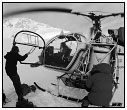
|
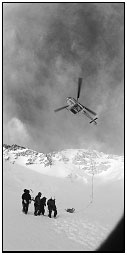
|
|
After Weider arrived at the
14,200-foot camp, one of the
patients he was called on to
tend was a 26-year-old Mexican
man suffering from high-altitude
pulmonary edema (top).
The man had been found
comatose and was brought to
the medical tent, pictured here.
The quarters are close and the
equipment basic, but it offers
the only medical refuge on
Denali. The man was given
oxygen, recovered consciousness,
and was then transported
off the mountain by rescue
helicopter (at right and above). |
Dr. Weider, sorry to wake you, but they need you again in the medical tent." It was 6:30 a.m., and the situation was even more serious. A 26-year-old Mexican climber was in a coma, suffering from severe pulmonary edema. Apparently, he had climbed for three days straight, directly from 7,000 feet on the Kahiltna Glacier to 14,200 feet, without taking the recommended rest days to get acclimated to the altitude. At sea level, a healthy individual has a blood-oxygen saturation level of nearly 100%. Halfway to the summit of Denali, 88% oxygen saturation is typical, but the Mexican climber registered only 37% and his lungs were so full of fluid that his breathing was barely audible. By administering 100% oxygen, Weider was able to get his saturation up to 52%—enough to keep him alive un- til a helicopter could evacuate him to a hospital in Anchorage.
Just an hour later, a Japanese mountaineer was brought into the medical tent, also suffering from pulmonary edema. When he was tested, his oxygen saturation registered 58%, and a helicopter evacuation was recommended for him as well. By 10:00 a.m., the medical tent had quieted and Weider had rejoined his group for the descent to 13,500 feet, where they retrieved the remainder of their gear and began the 700-foot climb back up to 14,200.
At 6:30 the following morning, Weider was again awakened with an urgent request for his medical expertise. Thousands of feet above his team, just below the summit of Denali, a terrifying drama was unfolding. Six British military mountaineers, less than a thousand feet from the peak, had been climbing in two teams of three when one of the teams fell. Two of the soldiers were injured and most of their equipment was swept away. Sergeant Martin Spooner suffered severely sprained ankles when he tried to arrest the trio's fall, and his teammate Lance Corporal Steve Brown appeared to have sustained head injuries. Brown began acting irrationally, removing his clothing in the howling, subzero gale just below the summit. With no tents, sleeping bags, or food, and with Spooner immobilized, the entire expedition was doomed unless help arrived quickly.
The third member of the stricken team, Phil Whitfield, had been only slightly injured in the fall, so he and a comrade from the other team, Johnny Johnson, were selected to descend for help. The fastest route to the medical aid station was down the infamous Orient Express, a 55-degree, 4,000-foot face of windblown snow the consistency of concrete. The route appears deceptively benign, but one misstep can result in a bone-smashing tumble down thousands of feet of bulletproof hard pack. Over the years, 15 climbers have lost their lives on the Orient Express, including many from Japan and Korea, thus giving the deadly slope its name.

| |

|

|
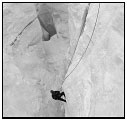
|
The vistas at every turn are
breathtaking. Here (top), the
17,400 peak of nearby Mount
Foraker juts above the clouds,
while the West Buttress of
Denali itself looms on the right.
But the scenery holds hazards
of all sorts. Above, a nearwhiteout
almost obscures the
rescue chopper. At the upper
left, two climbers negotiate a
vast, icy slope called "Windy
Corner," about 800 feet below
the 14,200-foot camp. And at
the lower left, a rescuer is lowered
into a crevasse. Over 120
people have lost their lives on
Denali since 1930, including
at least 30 in this decade. |
Whitfield and Johnson successfully negotiated the slope, arriving at the medical tent with the news not only of the British accident near the summit, but also of two injured American climbers at the base of the Orient Express. A rescue mission was immediately launched from the medical aid station to retrieve the downed Americans. With the arrival of the two British climbers, Weider was again pressed into action—this time sewing up one soldier's scalp lacerations with a first aid kit and the Leatherman pocket tool he'd brought from home.
Ten hours later, the rescue team returned with the two Americans —Jeff Munroe and Billy Finley. Their 3,000-foot fall on the Orient Express had left Finley with fractured ribs as well as knee and ankle injuries, while Munroe was unconscious and in critical condition. Fortunately, by that time, two other physician-climbers had arrived at 14,200 feet. Like Weider, Dr. Ed Donovan was not only an ear, nose, and throat specialist, but a Dartmouth graduate (Class of 1975) and from New Hampshire (Nashua), while Dr. David Moon was an emergency physician from the Denver area.
Due to the severity of Munroe's condition, the medical aid station was communicating by radio with emergency-room personnel in Anchorage, and at their suggestion Weider installed a nasotracheal tube to facilitate the administration of oxygen and medications. Munroe's symptoms suggested to Weider a subdural hematoma, but CAT scans later revealed an even more serious injury—a diffuse axonal shearing.
Helicopters were now poised for two missions—to evacuate the two injured Americans from the camp at 14,200 feet and to snatch the four stranded British soldiers from a narrow ledge at 19,000 feet. But throughout the afternoon and evening, the winds howled and the clouds swirled. At midnight, there was a momentary break in the clouds, the pilots scrambled, rescue personnel at 14,200 feet talked the chopper in by radio, and the injured Americans were whisked off the mountain. The remnants of the British team were still stuck at 19,000 feet, however.
Fifteen minutes after Weider had collapsed in his tent, he heard alarming news: "Grab your gear, boys, there's been another fall on the Orient Express!" Roger Robinson, a National Park Service ranger, had been watching a pair of climbers descend the treacherous snowfield through a telescope when the trailing climber fell and dislodged the lead climber; they both tumbled 1,500 feet to the spot where the Americans had been discovered the day before.
The unlucky pair turned out to be half of the remaining British crew. The leader of that expedition, Captain Justin Featherstone, had watched the condition of his men deteriorate as they remained weathered in just below the summit, and he had elected to guide the stilldisoriented Brown down the mountain to medical help. Corporal Carl Bougard, who had not been injured in the original fall, had volunteered to remain at 19,000 feet with his immobilized teammate, Martin Spooner. With Featherstone leading the way down the deadly Orient Express, Brown had stumbled, dislodging them both and puncturing his captain's leg with his sharp crampons.
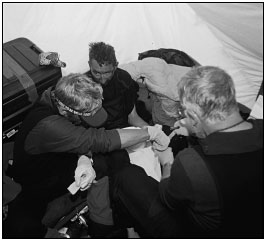
| |
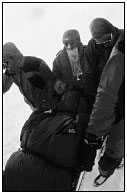
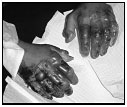
|
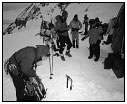
|
|
After several climbers suffered
serious falls, Weider's expertise
was again in demand at the
medical tent (top; Weider is on
the right). While rescuers
geared up to retrieve the stricken
teams (above) and transported
the injured climbers to help
(upper left), Weider tended to
head injuries, fractures, and
severe frostbite (lower left).
But no lives were lost while
Weider was on the mountain. | |
When their terrifying fall finally ended, Featherstone had sustained a broken leg in addition to the puncture wounds. Worse, the disoriented Brown unclipped himself from the tangled safety rope and wandered across the treacherous snowfield. Almost immediately he fell into a crevasse; he soon clawed his way back to the surface only to disappear into a deeper crevasse several meters further on. Brown was so disoriented that he didn't realize he had lost his mittens, and by the time the rescue team reached the two British climbers, Brown's hands were severely frostbitten.
The rescue team returned to camp with the injured climbers by 9:00 a.m., and Weider went to work again, first installing an IV line and then stabilizing Featherstone's broken tibia and fibula. At the lower altitude, Brown appeared to be acting more rationally, but his hands were so badly frostbitten that he would eventually lose most of his fingers.
That left two British climbers still stranded on a narrow ledge of packed snow at 19,000 feet. Spooner and Bougard had little in the way of survival gear, no food, and no radio. Spooner couldn't move due to his severely sprained ankles, and Bougard had long since lost all feeling in his feet due to the extreme cold plus a wind-chill factor that reached 100* below zero. And the stormy weather would still not permit a helicopter rescue attempt.
Meanwhile, given the welcome lull in activity at the medical tent, Weider's team elected to push on to 16,000 feet. Four members of the party had already decided to turn back. The second-oldest member of the team had headed down after four days on the mountain. Another climber in the group, whose mother had recently passed away, turned back under pressure from his family. Jim Jurrens, Weider's tentmate, a DHMC operating room nurse and the person who had proposed the expedition to Weider, was having difficulty sleeping and couldn't lie flat without experiencing significant shortness of breath, so he, too, reluctantly started back down. And a 34-year-old man from Massachusetts developed high-altitude pulmonary edema and was forced to call it quits.
The remaining five climbers and three guides struggled through an exhausting and frustrating day up to 16,000 feet, where a 34-year-old Texan and a junior guide who was suffering high-altitude headaches decided to turn back. That left Weider trying to keep pace with two 34-year-olds, a 44-year-old marathoner who was the most physically fit member of the group, and two highly experienced guides. For the first time on the expedition, Weider had to ask his teammates to slow down—but he felt bad, knowing he might be jeopardizing their chance to reach the summit. Having pushed himself to exhaustion many times before, Weider knew his physical limits better than most endurance athletes.
In 1987, Weider and his companion on many wilderness adventures, Willem Lange of Etna, N.H., skied the 210-mile Iditaski race on the same course used for the world-famous Alaskan Iditarod sled-dog competition. More recently, Weider was part of a Norwegian expedition that skied 240 miles across the Greenland ice cap. His tentmate for part of that trip had been Steve Fossett, the adventurer famous for several attempts to circumnavigate the globe in a hot-air balloon.
Weider was also one of several Dartmouth graduates who skied the Haute Route, a two-week ski trek through the Alps that begins in Chamonix, France, and culminates in Zermatt, Switzerland. Putnam Blodgett, DC '53, who organized that trip, says of Weider: "Amazing man! He does not at first glance seem especially strong, but, in fact, he's very tough. He also has the unique ability to appear attentive when he's actually sound asleep!"
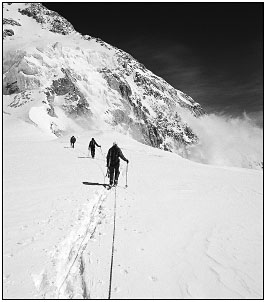
| |

|

|
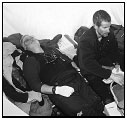
|
This snowfield near the 14,200-
foot camp (top) is known as the
"Edge of the World." The
14,200 camp is staffed by the
National Park Service during
the April-to-July climbing season
and features such amenities,
in addition to the medical tent,
as a kitchen tent (upper left),
outside which several climbers
are chowing down here, and a
latrine-with-a-view (above).
At the lower left, an exhausted
Weider catches a nap between
his stints in the medical tent. |
And in January of 1998, just six months before his Denali ascent, Weider had taken part in the first-ever full, 26-mile marathon held on the continent of Antarctica.
So more than most people, Dudley Weider knows his limits, and now, on Denali, he wasn't certain he had the conditioning necessary to reach the summit and to descend safely. Rather than force his teammates to slow down further, and perhaps risk their chance for success, Weider offered to return to 14,200 feet and continue his work at the medical tent while the others pushed on to the summit.
As his teammates continued up the mountain, the drama near the peak resumed. Finally the weather broke, and a helicopter located the stranded British soldiers. The pilots were astounded to see Spooner and Bougard alive and waving after several days of exposure to 80- mile-an-hour winds and temperatures that had dipped to minus 30* Fahrenheit. The rescue pilots dropped a survival package containing food, sleeping bags, a radio, and two "screamer suits"—body harnesses that allow climbers to be suspended from lines below a helicopter. Later, with the chopper refueled and the winds calm enough for the delicate maneuver, rescue pilot Jim Hood hovered over the injured climbers, who had donned the screamer suits, while they "clipped in" to the lines hanging from the aircraft.
Three minutes later, Hood landed at 14,200 feet, where the British mountaineers were rushed into the medical tent and their condition evaluated. Spooner was in good spirits in spite of his badly sprained ankles, but Bougard's feet were so badly frostbitten that eventually all of his toes had to be amputated. Once the helicopter returned from a refueling run to the Kahiltna Glacier, the injured climbers were loaded aboard and flown to Talkeetna, where a Life Flight jet was waiting to transport them to the hospital in Anchorage.
After Weider made his decision to stay at 14,200 feet, the three remaining members of his expedition pushed on to 17,500 feet, where they were weathered in for four days. On the fifth day they were finally able to reach the summit, although clouds obscured the view from the peak. After a few moments on the top of North America, they descended quickly to 14,200 feet, and Weider joined them for an agonizing race down to 8,000 feet. After a successful expedition, most mountain guides are determined to get their clients off the mountain as quickly as possible, before the weather turns sour—which, eventually, it always does.
Through a combination of good rescue work, good medicine, and good luck, no lives were lost in the accidents during the two weeks Weider was on Denali. Nevertheless, the series of mishaps was serious enough to garner widespread media coverage. Not only did Weider get his picture in the Anchorage Daily News, but the dramatic rescues were covered in the New York Times, Newsweek, numerous wire service stories, and on all the major network television news programs.
More than a year after his adventure on Denali, Dudley Weider remains in contact with many of the people he met there. Billy Finley wrote from Anchorage with an update on the slow but promising recovery of his climbing partner, Jeff Munroe: "I want to thank you for your help on the mountain. You were very professional, and without your help Jeff would have died."

| |

|

|
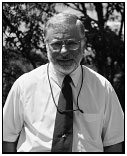
|
The rock-studded terrain at
16,500 feet (top) was about as
far as Weider got on this climb.
Above, he is pictured with the
five people in his original 12-
member team who reached the
20,320-foot summit; team
leader Chris Morris is on the
right and Weider is third from
the right. At the upper left,
Weider, left, relaxes with his
tentmate, Jim Jurrens, an OR
nurse at DHMC. And at lower
left is Weider in sea-level mufti. |
Park Ranger Roger Robinson also wrote, to inform Weider that he had been awarded the "Denali Pro" pin. "Thanks to your support, the complicated British and American rescue operations went smoothly and successfully. In recognition of your efforts, we present you with the 1998 Denali Pro pin. This climber recognition program is designed to recognize and reward mountaineers who reflect the highest standards in the sport for safety, self sufficiency, assisting other mountaineers, and 'no impact' expeditions."
Later still, Weider learned that out of 100 recipients of the Denali Pro pin during the 1998 climbing season, he was chosen for Honorable Mention as the "Denali Pro Mountaineer of the Year." In nominating Weider for the recognition, Park Ranger Robinson said, "I was amazed at his strength and determination. He was covered in sweat, carrying a heavy pack, and pulling a sled on his own climb, and within minutes of arriving at the 14,200-foot camp, he was assisting a climber suffering from serious chest pains."
Many adventurers who have survived the bone-numbing cold and crippling exhaustion of high-altitude mountaineering, when asked if they would ever return, answer simply, "Nope, once is enough." But Dudley Weider smiles as he admits that he has stayed in touch with many of the people he met on the slopes of Denali.
"Captain Featherstone, the British expedition leader, is determined to climb the mountain again, and he's asked Michael Dong, a medic from San Diego, and me to join him. Those guys wouldn't push the pace so hard. I'd do a lot more hiking with a heavy pack to get ready," Weider adds.
"Yeah," he grins, "I'd love another crack at reaching the top!"
John Morton was head coach of men's skiing at Dartmouth from 1978 to 1989. He now designs Nordic ski trails and writes about sports from his home in Thetford, Vt. His most recent book, A Medal of Honor, is a novel offering an insider's view of the Winter Olympics. He himself competed in the biathlon (which combines cross-country skiing and target-shooting) in the 1972 and 1976 Olympics. Scott Darsney of Mountainworld Images, who took the cover photo and many of the photos on the following pages, is a medic, experienced mountaineer, and professional photographer who was on Denali at the same time as Weider. The uncredited photos were taken by Weider or other members of his team.
